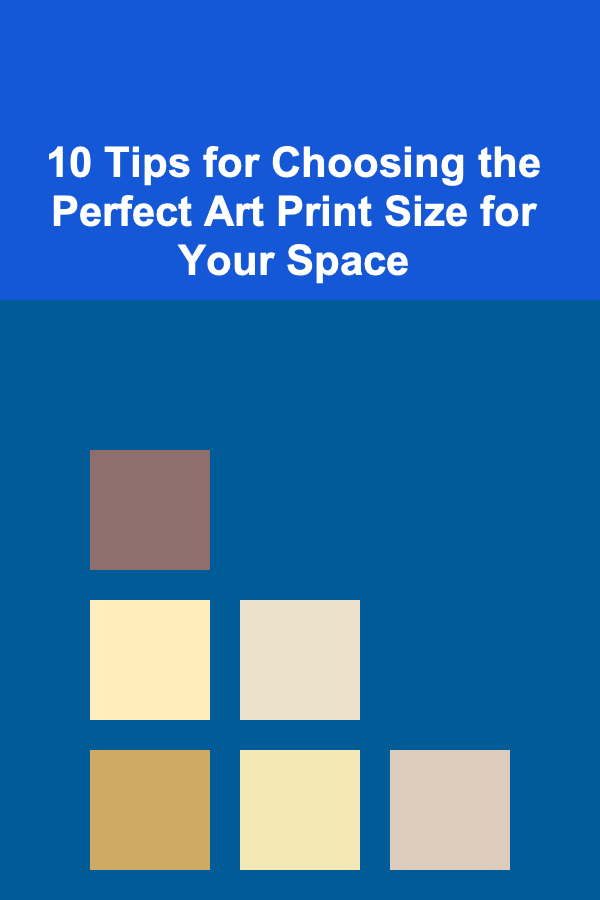
10 Tips for Choosing the Perfect Art Print Size for Your Space
ebook include PDF & Audio bundle (Micro Guide)
$12.99$5.99
Limited Time Offer! Order within the next:

Choosing the right art print size for your space can be an overwhelming task. The size of the artwork can drastically affect the mood, perception, and style of a room. Whether you're decorating a cozy nook, a spacious living room, or a sleek office, selecting the correct art print size is crucial for achieving harmony and balance. In this article, we will explore ten tips to help you choose the perfect art print size for your space.
Understand the Space and Room Dimensions
Before you even think about the type of art you want, the first step in choosing the perfect print size is understanding the space in which the artwork will reside. Measure the dimensions of the wall or area where the art will hang. The size of the wall will determine the maximum size the print can be.
A general rule of thumb is that artwork should cover around two-thirds of the wall space for a balanced and proportional look. If you have a small wall, choose a smaller print, while larger walls can accommodate bigger pieces.
Pro Tip: If you're working with an oversized wall, you can opt for a large art print or even a series of smaller pieces that form a cohesive gallery wall.
Consider the Room's Function
The function of the room should influence the size and style of the art print. Different rooms in the house have different energy, and art can either enhance or disrupt that energy depending on its size.
- Living rooms are typically the focal point of the home and can accommodate large prints, especially if the wall has a significant expanse. Consider larger-scale art to create impact.
- Bedrooms may require smaller or more intimate pieces. A print above the bed should not overwhelm the space but complement the restful nature of the room.
- Kitchens often benefit from smaller art prints, such as food-related pieces, quotes, or abstracts.
- Hallways or corridors can be ideal for narrow, vertical prints or gallery-style arrangements.
By thinking about how the room is used, you can select art that fits both the space and the atmosphere you wish to create.
Pay Attention to the Wall's Shape and Proportions
Not all walls are created equal. Some may be wide and short, while others may be tall and narrow. The shape and proportions of the wall will dictate how you select the art print size.
- Wide walls: For horizontal or wide spaces, choose artwork that is more expansive horizontally, allowing the print to stretch across the wall without feeling cramped.
- Narrow walls: For vertical spaces, a portrait-oriented art print works well and creates a sense of height. You could also consider a vertical gallery of smaller prints.
The goal is to ensure that the artwork fills the space without overwhelming it, so the shape and proportions of the wall are critical factors in choosing the right print size.
Opt for Proportional Art Sizes
Once you've measured the wall and considered its proportions, ensure that the artwork fits within those measurements proportionally. Overly large or small prints can look out of place.
- Proportions: The print should not be too large for the wall, nor should it be so small that it gets lost against the surrounding space. A good rule is that the art should take up about 60% to 75% of the available wall space, depending on the wall's size.
If you're unsure about a specific size, cut out a piece of paper the size of the print you are considering and tape it to the wall. This will give you a visual reference to understand how it will look in the space.
Think About Groupings of Art
If a single print feels too small for a large wall or if you're not sure about committing to one large piece, consider creating a gallery wall or grouping multiple prints together. When grouping art, be sure to maintain consistency in style, color palette, or framing to create a cohesive visual effect.
Here are some ideas for effective groupings:
- Three-piece arrangement: A common and balanced choice, where three prints are hung in a row or as a triptych.
- Grid layout: A grid of smaller prints is ideal for creating uniformity and can work well in modern spaces.
- Random collage: If you prefer a more eclectic or creative look, arrange your prints in a seemingly random manner for a more relaxed vibe.
In any case, always keep the proportions of the space in mind to avoid overcrowding the wall or making it feel too empty.
Consider the Frame Size and Style
The frame you choose can influence the overall look of the art and the perception of its size. Frames can add visual weight to the piece, making it appear larger, or they can complement a minimalist aesthetic, allowing the artwork itself to shine.
- Thick, heavy frames: These frames will make the artwork appear larger and more substantial.
- Thin, delicate frames: These frames give the artwork a lighter feel, allowing the piece itself to take center stage without drawing too much attention to the frame.
When selecting a frame, ensure that it enhances the overall design of the room and doesn't overpower the artwork or the space.
Be Mindful of Wall Color and Texture
The color and texture of the wall on which the artwork is hung can impact how the print looks. A piece of art can pop against a neutral-colored wall or blend into a more vibrant background.
- Light-colored walls: These provide a great contrast for darker or more saturated prints, making the artwork stand out.
- Dark-colored walls: These work better with lighter, more vibrant prints that can pop against the rich background.
If the wall has a unique texture, such as exposed brick or rough plaster, you may want to select an art print that complements the wall rather than competes with it.
Think About Art's Purpose in the Room
Before settling on an art size, think about the emotional or aesthetic purpose of the art in the space. Art can be used to create a mood, fill an empty space, or make a bold statement. If the purpose of the artwork is to be a focal point, opt for a larger piece that stands out.
- Statement pieces: If you're using art to make a statement, consider going for something large and bold, like a large abstract painting or a vibrant photograph.
- Subtle accents: If you're looking for something more understated, smaller prints that complement the room's color palette and furniture work best.
The size of the print will affect the overall impact, so think about how you want your art to fit into the broader design of the room.
Take Lighting into Account
The way the art is lit can make a huge difference in how the piece is perceived. Lighting can highlight a smaller print or make a large piece feel more intimate. When deciding on the size of your artwork, consider how the lighting in the room will affect it.
- Track lighting or spotlights: These types of lighting work well with larger pieces of art to highlight their details.
- Ambient lighting: If your room has ambient lighting, smaller art prints will blend more seamlessly into the environment, while larger prints may require direct lighting to make a statement.
Ensure that the light not only complements the art but also enhances its visual appeal without creating glare or shadows.
Trust Your Instincts
Lastly, one of the most important tips is to trust your instincts. While all the guidelines above can be helpful, personal preference plays a key role in choosing the perfect print size. The art you select should resonate with you, enhancing your space in a way that makes you feel comfortable and inspired. Don't be afraid to experiment with different sizes or arrangements to see what feels right.
Art is subjective, and what works for one person might not work for another. The beauty of art is that it's about personal expression and how it connects with the viewer.
Conclusion
Choosing the perfect art print size for your space is more than just a practical decision; it's an opportunity to enhance the overall aesthetic and mood of a room. By considering factors such as the room's dimensions, wall shape, function, and the style of your art, you can create a balanced, harmonious environment. Pay attention to details such as frame styles, lighting, and the emotional tone of the room to ensure the art fits seamlessly into the space. Ultimately, the perfect print size is one that reflects your personal style, enhances the room's atmosphere, and creates a visual connection with the space.
Reading More From Our Other Websites
- [Organization Tip 101] How to Organize Your Gardening Tools for Easy Access
- [Sewing Tip 101] Best Modern Garment Construction Patterns: A Contemporary Sewing Roadmap
- [Needle Felting Tip 101] Essential Tools & Materials for Starting Needle Felting Projects
- [Personal Care Tips 101] How to Find Acne Treatment Creams That Won't Clog Pores
- [Organization Tip 101] How to Create an Accessible Shoe Organization System
- [Metal Stamping Tip 101] How CNC Metal Stamping Is Revolutionizing High-Volume Production
- [Gardening 101] Budget‑Friendly Garden Fence Ideas: Beauty Without Breaking the Bank
- [Home Maintenance 101] How to Keep Your Home's Garage Door Working Smoothly
- [Personal Investment 101] Turning Deep Learning into a Profitable Passive Income Source
- [Personal Care Tips 101] How to Shave with a Razor While Avoiding Razor Cuts and Nicks

Building AI-Based Products for Recurring Revenue with Deep Learning
Read More
How to Incorporate Energy-Efficient Lighting into Your Home
Read More
How to Market Your Health and Nutrition Services to Individuals and Businesses
Read More
How to Share Antique Knowledge with the Next Generation
Read More
Why You Should Keep a Home Inventory for Insurance Purposes
Read More
How to Promote Wildlife-Friendly Resorts
Read MoreOther Products

Building AI-Based Products for Recurring Revenue with Deep Learning
Read More
How to Incorporate Energy-Efficient Lighting into Your Home
Read More
How to Market Your Health and Nutrition Services to Individuals and Businesses
Read More
How to Share Antique Knowledge with the Next Generation
Read More
Why You Should Keep a Home Inventory for Insurance Purposes
Read More